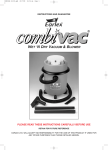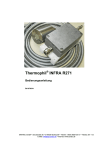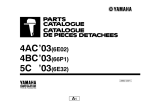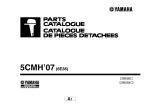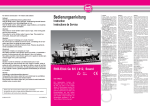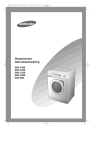Download Euphonix 740.006 User's Manual
Transcript
www.phoenix-mt.com PHÖNIX Messtechnik GmbH Magnetgesteuerte Grenzschalter Typ 740.0060 Typ 740.0065 Typ 740.0065NA BEDIENUNGSANLEITUNG Magnetically operated Level Switch Type 740.0060 Type 740.0065 Type 740.0065NA INSTRUCTION MANUAL PHÖNiX Inhaltsverzeichnis 1 2 3 ALLGEMEINE BESCHREIBUNG 1.1 Typ 740.0060 3 1.2 Typ 740.0065/65N 3 MONTAGEHINWEISE 4 2.1 Lieferzustand 4 2.2 Umkehr der Wirkungsrichtung 4 INBETRIEBNAHME 5 3.1 Montage 5 3.2 Elektrischer Anschluss 5 3.2.1 Leistungsschalter 5 3.2.2 Kleinsignalschalter 6 3.2.3 Namur-Schalter 6 3.3 4 3 Grundeinstellung des Schaltzustandes 6 BEDIENUNG 6 4.1 Zweipunkt-Regelung mit 740.0060 6 4.2 Einsatz des Typs 740.0065NA im explosionsgefährdeten Bereich 7 4.3 Hitzeschutzblech für erhöhte Temperaturen 7 5 WARTUNG 7 6 GARANTIE 7 7 ENTSORGUNG 8 8 STÖRUNGSBEISTAND 8 9 TECHNISCHE DATEN 8 1 GENERAL 9 2 1.1 Type 740.0060 9 1.2 Type 740.0065/65NA 9 MOUNTING INSTRUCTIONS 10 PHÖNIX Messtechnik GmbH, Salzschlirferstr. 13, D-60386 Frankfurt/M., Germany, Tel: +49/69/416742 -20, Fax: -29 1 3 2.1 Delivery 10 2.2 Reversing the direction of switching 10 COMMISSIONING 3.1 Mounting 11 3.2 Electrical connections 11 3.2.1 Power switch 11 3.2.2 Miniswitch 11 3.2.3 Namur switch 12 3.3 4 11 Setting the switch position 12 OPERATING INSTRUCTIONS 12 4.1 Two-step action with overlap with one PHÖNIX type 740.0060 level switch 12 4.2 Using the type 740.0065NA in a hazardous area 13 4.3 Heat protection in high temperature 13 5 MAINTENANCE 13 6 WARRANTY 13 7 DISPOSAL 14 8 TROUBLE SHOOTING 14 9 TECHNICAL DATA 14 PHÖNIX Messtechnik GmbH, Salzschlirferstr. 13, D-60386 Frankfurt/M., Germany, Tel: +49/69/416742 -20, Fax: -29 2 1 Allgemeine Beschreibung Die PHÖNIX Grenzschalter Typ 740.0060/65 werden zusammen mit magnetisch gesteuerten Flüssigkeitsstandanzeigern verwendet. Ihr Schaltverhalten ist bistabil. Bei Stromausfall und -wiederkehr ist der Schaltzustand durch magnetische Speicherung stets aktuell. Die Wirkungsrichtung des Schaltvorgangs ist durch Montage der Platine umkehrbar (Kap. 2.2). Der Grenzschalter besitzt eine Hysterese, die vom verwendeten Anzeiger abhängig ist (s. Kap. 9). Hierdurch ergibt sich die Möglichkeit einer Zweipunkt-Regelung. Auch für den Einsatz in Anlagen mit starken Vibrationen ist dieser Schalter aufgrund des massearmen Schaltelements gut geeignet. 1.1 Typ 740.0060 Mit dem PHÖNIX Grenzschalter Typ 740.0060 sind zwei Betriebsarten möglich: a) Der Betrieb als elektronischer Leistungsschalter. Diese Betriebsart empfiehlt sich zum Schalten großer Lasten an Wechselspannung, da die Lastschaltung kontaktlos erfolgt (Triac). Schutzmaßnahmen für den Reedkontakt entfallen, da dieser lediglich den Steuerstrom des Triac schaltet. b) Der Betrieb als Kleinsignalschalter. Diese Betriebsart ist angebracht zum Schalten von 0/4...20 mA Stromschleifen, NAMUR Signalen, Logikpegeln, kleinen Wechsel- oder Gleichspannungen, etc. ACHTUNG: Die gleichzeitige Verwendung beider Betriebsarten ist nicht möglich! Last Abb. 1: Prinzipschaltung 740.0060 1.2 Typ 740.0065/65N Der Grenzschalter Typ 740.0065 (Abb. 2a) ist die zum ausschließlichen Betrieb als Kleinsignalschalter reduzierte Variante des Typs 740.0060. Der Typ 740.0065NA ist zusätzlich - wie in Abb. 2b dargestellt mit Widerständen (RS=1k, RP=10k) bestückt, um in Namurschaltkreisen eingesetzt werden zu können. Abb. 2b: Prinzipschaltung 740.0065NA Abb. 2a: Prinzipschaltung 740.0065 PHÖNIX Messtechnik GmbH, Salzschlirferstr. 13, D-60386 Frankfurt/M., Germany, Tel: +49/69/416742 -20, Fax: -29 3 2 Montagehinweise 2.1 Lieferzustand Die PHÖNIX Grenzschalter Typ 740.0060/65 werden ausgeliefert wie in der nachstehenden Abb. 3a dargestellt: AUS EIN Abb. 3a: Lieferzustand EIN AUS Abb. 3b: nach Umkehr der Wirkrichtung 2.2 Umkehr der Wirkungsrichtung Eine Umkehr der Wirkungsrichtung entspricht der entgegengesetzten Schaltfunktion bei gleicher Magnetpolarität. Dabei ist darauf zu achten, dass die Kabelverschraubung immer nach unten zeigt, wie in den Abb. 3a und 3b dargestellt. Vorgehensweise: • • • • Abnehmen des Gehäusedeckels Abnehmen der Sicherheitsabdeckung (nur beim Typ 740.0060) Bei Bedarf: Abklemmen aller Anschlussdrähte Entfernen der Schraube und des Sechskantbolzens sowie der Erdungsschraube beim Aluminiumgehäuse • Nach Drehen der Platine um 180° Schraube, Sechskantbolzen sowie Erdungsschraube beim Aluminiumgehäuse wieder einsetzen PHÖNIX Messtechnik GmbH, Salzschlirferstr. 13, D-60386 Frankfurt/M., Germany, Tel: +49/69/416742 -20, Fax: -29 4 • • • • Anklemmen der Anschlussdrähte Anbringen der Sicherheitsabdeckung (nur bei Typ 740.0060, sehr wichtig !!) Lösen des Halters Montage des Halters an der gegenüberliegenden Seite. Um den Abstand aufrecht zu halten die zweite Reihe Bohrungen benutzen. • Anbringen des Gehäusedeckels 3 Inbetriebnahme Der Anschluss darf nur von geschultem Fachpersonal unter Einhaltung der einschlägigen Sicherheitsvorschriften vorgenommen werden 3.1 Montage Die Montage des Schalters erfolgt mittels der zwei mitgelieferten Spannbänder wie in Abb. 4 dargestellt. Die PG - Verschraubung hat stets nach unten zu zeigen, der Schaltpunkt liegt etwa auf halber Gehäusehöhe. Die optionale Hitzeschutzplatte befindet sich zwischen Gehäuse und Haltewinkel. Gehäuse Montagewinkel Befestigungsschrauben Halter optionaler Hitzeschutz Schaltpunkt Bänderpaar M20x1,5 Abb. 4: Montage des Schalters mittels der mitgelieferten Spannbänder 3.2 Elektrischer Anschluss 3.2.1 Leistungsschalter Bei Betrieb mit Wechselstrom ist die Funktion der eines mechanischer Schalter vergleichbar, beispielsweise können als Last Relais, Schütze, Magnetventile etc. geschaltet werden. Aufgrund der Beschaltung (s. Abb. 1) des Halbleiterschaltelements (Triac) fließt jedoch auch im geöffneten Zustand ein geringer Strom über C1 (47nF). Last Abb. 5b: Minimal Last Abb. 5a: Anschluss als Leistungsschalter PHÖNIX Messtechnik GmbH, Salzschlirferstr. 13, D-60386 Frankfurt/M., Germany, Tel: +49/69/416742 -20, Fax: -29 5 3.2.2 Kleinsignalschalter In dieser Schaltung ist der Grenzschalter ein normaler mechanischer Schalter (Reedkontakt) für kleine Gleich- oder Wechselspannungen. Für den Reedkontakt sind daher die üblichen Schutzmaßnahmen vorzusehen (s. Abb. 6b). Bei Schaltspannungen >24V ist beim Typ 740.0060 R1 zu entfernen (s. Abb. 1). Kleinlast Grenzwerte (s. Kap. 9) und Schutzmaßnahmen (s. Abb. 6b) beachten. Abb. 6b: Schutzmaßnahmen für Gleich- und Wechselspannungen Abb. 6a: Anschluss als Kleinsignalschalter 3.2.3 Namur-Schalter Abb. 7: Anschluß als Namur-Schalter 3.3 Grundeinstellung des Schaltzustandes Vor der Inbetriebnahme muss jeder Schalter in die richtige Schaltlage gebracht werden, abhängig von der Position des Schwimmers. Dies kann mit Hilfe eines Richtmagneten (BG10XXXXMAKU, im Lieferumfang der PHÖNIX - Anzeiger enthalten) erfolgen, der am Gehäuse vorbei in Pfeilrichtung (vergl. Abb. 3a und 3b) bewegt wird. Der Richtmagnet kann auch geringfügig seitlich am Gehäuse vorbei bewegt werden. Der Schaltzustand kann durch Anschluss eines Durchgangsprüfers (Summer, Ohmmeter) an den Klemmen 1 und 3 überprüft werden. Dabei ist die Betriebsspannung abzuschalten! 4 Bedienung 4.1 Zweipunkt-Regelung mit 740.0060 Aufgrund der Hysterese (s. Kap. 9) des bistabilen Schaltelements kann der Schalter zur Zweipunktregelung von Flüssigkeitsständen verwendet werden. PHÖNIX Messtechnik GmbH, Salzschlirferstr. 13, D-60386 Frankfurt/M., Germany, Tel: +49/69/416742 -20, Fax: -29 6 Abb. 8: Verwirklichung einer Zweipunkt-Regelung mit einem PHÖNIX Grenzschalter Typ 740.0060 unter Ausnutzung der Schalthysterese 4.2 Einsatz des Typs 740.0065NA im explosionsgefährdeten Bereich Durch Beschaltung des Reedkontakts mit Widerständen gemäß Abb. 2b ist der Typ 740.0065NA für den Einsatz in Namurschaltkreisen geeignet. Da nur passive elektrische Bauteile eingebaut sind, deren Erwärmverhalten eindeutig festliegt, ist der Schalter nach VDE165 per Herstellerbescheinigung auch für den Einsatz in explosionsgefährdeten Bereichen der Zonen 1 und 2 zugelassen. Die maximale Eigenerwärmung wird durch RS (RT= 180°C/W) und den Grenzwerten des verwendeten Trennschaltverstärkers festgelegt. Bei Verwendung des Typs 740.1061 (Pmax=51mW) beträgt diese höchstens 10°C. Typ 740.0065N Typ 740.0065N ExBereich sicherer Versorgungsspannung Bereich Abb. 9: Verwendung des Typs 740.0065NA im explosionsgefährdeten Bereich 4.3 Hitzeschutzblech für erhöhte Temperaturen Bei Mediumtemperaturen >150°C (>260 °C bei 740.0065NA) ist zur Verringerung der Wärmeeinstrahlung vom Anzeiger eine Hitzeschutzplatte (Best.-Nr.: 5745000159) zwischen Anzeiger und Schalter einzubauen. Der Schalter darf dann auf keinen Fall mit dem Anzeiger einisoliert werden. 5 Wartung Die Schalter 740.0060/65/65N sind wartungsfrei. 6 Garantie Wir gewähren auf unsere Produkte eine Garantiezeit von 24 Monaten. Vorraussetzung ist die sachgemäße Behandlung entsprechend der Bedienungsanleitung. Bei Verschleiß- und Ersatzteilen beschränkt sich die Garantie auf Material - und Konstruktionsfehler. PHÖNIX Messtechnik GmbH, Salzschlirferstr. 13, D-60386 Frankfurt/M., Germany, Tel: +49/69/416742 -20, Fax: -29 7 7 Entsorgung Der Kunde übernimmt die Pflicht, die gelieferte Ware nach Nutzungsbeendigung auf eigene Kosten nach den gesetzlichen Vorschriften ordnungsgemäß zu entsorgen. 8 Störungsbeistand Fehler keine Funktion kein bistabiles Verhalten kein Öffnen (740.0060) öffnet spontan (Kleinsignal) Ursache Verdrahtung, Sicherung, Versorgung Halter falsch montiert Leistungsschalter: Laststrom zu klein Kleinsignalschalter: Spannung > 24V Last zu groß Temperatur zu hoch Abhilfe überprüfen auf Abstand setzen Reedschalter verwenden Widerstand R1 entfernen Schaltverstärker verwenden Hitzeschutzblech (-platte) verwenden Für weitere Unterstützung steht die Firma PHÖNIX Messtechnik GmbH zur Verfügung. 9 Technische Daten Allgemeine Daten Auslegungsdaten Hysterese ca. [mm] 6 10 15 max. Gehäusemax. Mediumstemp. temperatur. Verwendung als mit Heizmantel 15 20 25 Leistungsschalter (Triac) Kabelverschraubung nach unten IP65 Alu/Makrolon mit Bänderpaar, Best.Nr. s. Seite 2 Makr.: 82x80x55/0,15 kg Alu: 75x80x57/0,3 kg Kleinsignalschalter (Reed) Makr. Alu Makr. 710.104/2XX 710.100 710.110...160 ohne Heizmantel 150 °C *) bei Umg.Temp.85 °C 70 °C 400 °C *) bei Umg.Temp.55 °C 90 °C 150 °C *) bei Umg.Temp.120 °C 120 °C Alu Anzeiger-Typ 500 °C *) bei Umg.Temp.70 °C 120 °C *) Isolierung zwischen Schalter und Anzeiger ab 150 °C im Rohr (ab 260 °C bei 740.0065NA) Elektrische Daten Leistungsschalter Elektrische Daten Kleinsignalschalter1) Betriebsspannung Nennwert: Betriebsspannung Grenzwert: Lastrom Nennwert: AUS-Strom (230 V~) max. Schaltleistung: Max. Betriebsspannung : 1) Max. Laststrom : 1) Max. Schaltleistung : Beachten Sie die in 3.2.2 vorgeschlagenen Schutzmassnahmen beim Schalten induktiver Lasten! - 1) 1) 24 V~ bis 230V~ 250 V~ 24 mA~ bis 2,5 A~ 6 mA~ 550 VA 400 V= / 230 V~ 0,5 A 5W Es gilt zu beachten, dass keiner der drei Parameter Umax, Imax, Pmax überschritten werden darf! PHÖNIX Messtechnik GmbH, Salzschlirferstr. 13, D-60386 Frankfurt/M., Germany, Tel: +49/69/416742 -20, Fax: -29 8 1 General The PHÖNIX type 740.0060/65 level switches can be used on all PHÖNIX magnetically-operated level gauges. The switching behaviour is bistable. Should the electrical supply fail and return, the position of the impulse magnet will be "memorised". The direction of the switching can be changed by reversing the printed circuit board (see chapter 2.2). The level switch hysteresis depends on the liquid level gauge (s. chapter 9) and can be used as a twostep action. Because of its low mass switching element this level switch is particularly suitable in installations with strong vibrations, 1.1 Type 740.0060 Two types of operation are available with the PHÖNIX type 740.0060 level switch. a) Used as electronic power switch, it is recommendable for the switching of heavy AC-loads, as the switching occurs contactless (TRIAC). Protective measures for the REED-switch are not necessary, as it is only used for the control circuit of the TRIAC, b) Used as a Reed miniswitch, it is usable for the switching of 0/4-20 mA current loops, NAMUR-signals, logic levels, small AC/DC-voltages etc. ATTENTION: TRIAC and REED cannot be used at the same time! Fig.1 Circuit design 740.0060 1.2 Type 740.0065/65NA The level switch type 740.0065 (fig. 2a) is reduced to a Reed miniswitch for low level AC/DC loads. The type 740.0065NA is alternative - as shown in fig. 2b - fitted with two resistors (RS=1k, RP=10k) for usage in NAMUR circuits. Fig. 2b: Circuit 740.0065NA Fig. 2a: Circuit 740.0065 PHÖNIX Messtechnik GmbH, Salzschlirferstr. 13, D-60386 Frankfurt/M., Germany, Tel: +49/69/416742 -20, Fax: -29 9 2 Mounting instructions 2.1 Delivery The PHÖNIX type 740.0060/65 level switch can be delivered in the configurations shown below: OFF ON Fig. 3a: as delivered ON OFF Fig. 3b: with inverted switching direction 2.2 Reversing the direction of switching A reversal of the direction of switching involves the opposite switching function. Please note that the cable-gland is always directed downwards, as shown in fig. 3a and 3b. Instruction: • • • • • Remove the switch cover Remove the safety access panel (type 740.0060 only) If necessary remove all connecting wires from the terminal Take off screw, hexagon bolt and - for aluminium housing - the earth terminal After turning the circuit board 180° remount with screws , hexagon bolt and.- for aluminium housingthe earth terminal. • Reconnect the wires into the terminal • Put on the safety access panel (type 740.0060 only, very important !!) PHÖNIX Messtechnik GmbH, Salzschlirferstr. 13, D-60386 Frankfurt/M., Germany, Tel: +49/69/416742 -20, Fax: -29 10 • Mount the bracket on the opposite side of the switch box. Use the second row of holes to keep the distance. • Remount the switch cover 3 Commissioning Authorised skilled personnel only recommended to connect the electrical circuits. 3.1 Mounting The mounting of the switch is done by two collars, which are supplied together with the switch, as shown in Fig. 4. The cable gland is directed downwards in any case. The switching point is situated nearby the middle of the box. The heat protection is optional for high temperature applications and is situated between the switch box and the mounting bracket. housing mounting bracket mounting screws holder optional heat protection switching point collars M20x1,5 Fig. 4: The mounting to the tube is done by two collars. 3.2 Electrical connections 3.2.1 Power switch In AC applications the function is comparable to a mechanically operating switch and can be used in conjunction with load relays, gate switches, solenoid valves etc. Because of the wiring (fig. 1) of the solid state switch (Triac) a small permanent current will pass through C1 (47nF). Last Fig. 5b: Minimum load Fig. 5a: Connected as a power switch 3.2.2 Miniswitch For this type of operation, the PHÖNIX type 740.0060 level switch is used as a normal mechanical (REED) switch for low AC/DC-currents. The usual safety precautions for Reed switch contacts must be observed (s. fig. 6b). PHÖNIX Messtechnik GmbH, Salzschlirferstr. 13, D-60386 Frankfurt/M., Germany, Tel: +49/69/416742 -20, Fax: -29 11 For switch type 740.0060 at voltages >24 V remove the resistor marked with R1 (s. fig. 1). low load Please observe limit values (chapter 8) and safety precautions (s. fig. 6b). Fig. 6b: safety precautions for operation in low DC/AC circuits. Fig. 6a: Connected as a mini switch 3.2.3 Namur switch 740.0065NA Fig. 7: Connecting of the Namur switch 3.3 Setting the switch position Before starting-up, the bistable Reed contact must be properly set, in relation to the float in the level gauge. This can be accomplished by using the control magnet (PHÖNIX part BG10XXXXMAKU, delivered with liquid level gauges). This is moved up or down along the switch according to figs. 3a and 3b. The switching function can be tested using an appropriate alarm or ohmmeter on the terminals 1 and 3. In this case the system voltage, external wires must be disconnected ! 4 Operating instructions 4.1 Two-step action with overlap with one PHÖNIX type 740.0060 level switch Due to the Hysteresis of the bistable level switch type 740.0060 (see chapter 9) it can be used for a twostep action of liquid levels. PHÖNIX Messtechnik GmbH, Salzschlirferstr. 13, D-60386 Frankfurt/M., Germany, Tel: +49/69/416742 -20, Fax: -29 12 Fig. 8: A two-step action with a PHÖNIX level switch type 740.0060 utilising its hysteresis. 4.2 Using the type 740.0065NA in a hazardous area The limit switch type 740.0065NA is designed for usage in NAMUR-circuits (s. fig. 2b). It consists only of passive devices (switch and resistors), which allows - according to EN 50020 / VDE 0170 part 7 - the usage in hazardous areas zone 1 and 2, if they are part of a intrinsic save circuit and the maximum values of voltage, current and power are not exceeded. The maximum of self heating is determined by RS (RT= 180°C/W) and the utilised power supply. If using the type 740.1061 (Pmax=51mW), the heating up is less than 10°C. Typ 740.0065N Typ 740.0065N hazardous safe area area supply Fig. 9: Usage of the type 740.0065NA in a hazardous area 4.3 Heat protection in high temperature If medium temperature is more than 150°C (>260 °C for 740.0065NA) to reduce the heat radiation a heat protection plate (Order-No.: 5745000159) has to be mounted between the tube and the switch. In this case the switch must not be isolated together with the tube. 5 Maintenance The switch is free of maintenance. 6 Warranty We grant a guarantee period of 24 months for our products, provided that they have been handled and operated under conditions described in the Operating Manual. In case of wear and spare parts we only guarantee for failures in construction and material. PHÖNIX Messtechnik GmbH, Salzschlirferstr. 13, D-60386 Frankfurt/M., Germany, Tel: +49/69/416742 -20, Fax: -29 13 7 Disposal The customer/enduser is obliged to take care for the disposal within the legal regulations. 8 Trouble shooting Failure no function no bistable behaviour the switch is always closed (740.0060) the switch opens spontaneously (miniswitch) Problems wrong wiring, fuses, current supply wrong mounting of the housing power switch: low current Mini-switch: supply voltage > 24V load is too high temperature is too high Correction check it rise distance use it as a mini-switch remove resistor R1 use an isolating switch amplifier use a heat protection plate 9 Technical Data General Data Design Data Hysteresis ca. [mm] 710.104/2XX 710.100 710.110...160 6 10 15 on heating jacket Cable gland downwards IP65 Alu/Makrolon with strap retainers (Accesories s. page 2) Makr.: 82x80x55/0,15 kg Alu: 75x80x57/0,3 kg Electrical data power switch Operating voltage nominal: Operating voltage limit: Load current nominal: OFF-current (230 V~) max. power limit: - 1) Power switch (Solid state Triac-relay) 15 20 25 Small signal switch (Reed) Makr. Alu Makr. on basic pipe max. temp. of housing 150 °C *) at amb.Temp.85 °C 70 °C 400 °C *) at amb.Temp.55 °C 90 °C 150 °C *) at amb.Temp.120 °C 120 °C Alu Gauge-Type max. temperature of pipe Operating mode 500 °C *) at amb.Temp.70 °C 120 °C *)Insulate between housing and pipe above 150 °C in pipe (>260 °C for 740.0065NA) Electrical data miniswitch 24 V~ to 230V~ 250 V~ 24 mA~ to 2,5 A~ 6 mA~ 550 VA Operating voltage limit: Operating current limit: Rupturing capacity UxImax: 400 V= / 230 V~ 0,5 mA 5W Take into account that none of the three parameters Umax, Imax, Pmax may be exceeded! PHÖNIX Messtechnik GmbH, Salzschlirferstr. 13, D-60386 Frankfurt/M., Germany, Tel: +49/69/416742 -20, Fax: -29 14 PHÖNiX www.phoenix-mt.com PHÖNIX Messtechnik GmbH PHÖNIX Messtechnik GmbH Salzschlirfer Straße 13 D-60386 Frankfurt Tel. +49/69/41 67 42 - 20 Fax +49/69/41 67 42 - 29 Internet: http://www.phoenix-mt.com e-mail: [email protected] Weitere Produkte: Further products: Schauglasanzeiger Sight Glass Level Gauges Magnetanzeiger Magnetic Level Gauges Schwimmmerschalter Float Switches Schwimmer Füllstandmesser Float Level Gauges Verdränger Füllstandmesser Displacer Level Gauges Ultraschall Füllstandmesser Ultrasonic Level Gauges Optoelektronische Grenzwertgeber Optoelectronic Level Switches Ultraschall Grenzschalter Ultrasonic Switches DR7400060 REV. 26-10-06 PHÖNIX Messtechnik GmbH, Salzschlirferstr. 13, D-60386 Frankfurt/M., Germany, Tel: +49/69/416742 -20, Fax: -29 15
This document in other languages
- Deutsch: Euphonix 740.006
















